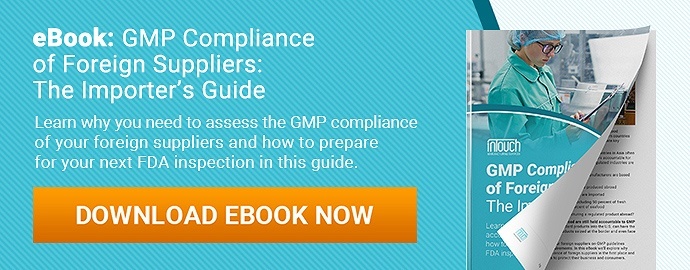 Some importers think they’re shielded from FDA regulations because they outsource manufacturing to factories abroad. You might ask yourself, what are the odds the FDA is actually going to inspect my foreign facility?
Some importers think they’re shielded from FDA regulations because they outsource manufacturing to factories abroad. You might ask yourself, what are the odds the FDA is actually going to inspect my foreign facility?
It turns out the odds are much higher than you might think.
The number of Chinese drug manufacturing facilities the FDA inspected grew 66 percent from 2011 to 2016. And the FDA will double their foreign food inspections every year over the next five years, as mandated by the Food Safety Modernization Act from 2011.
Most countries rely on good manufacturing practice (GMP) regulations to protect consumers from unsafe products (related: GMP Compliance of Foreign Suppliers: The Importer’s Guide [eBook]).
Regulatory agencies like the U.S. Food and Drug Administration (FDA) used to focus primarily on domestic GMP compliance and enforcement. But the number of FDA inspections abroad has grown as importers increasingly source products abroad.
The importer still bears the brunt of the consequences for violations found during an FDA inspection of their foreign supplier’s facility.
Don’t take any chances with GMP compliance. Ensuring FDA inspection readiness at all your suppliers’ facilities won’t only help you prepare for an official FDA inspection. It will also help you protect your customers from potentially unsafe products.
4 types of FDA inspections to prepare for
The first step to ensuring FDA inspection readiness is to familiarize yourself with the various types of inspections. The FDA conducts four different types of inspections to ensure the GMP compliance of regulated facilities. The FDA initiates each one based on different criteria.
1. Pre-approval inspections for first-time product applications
The pre-approval inspection (PAI) assesses a manufacturing plant’s production capabilities. PAI seeks to establish whether the plant can adequately manufacture the product it’s applying to sell.
Any manufacturing plant named for the first time in the following applications is subject to pre-approval inspection:
- New drug application (NDA) and abbreviated new drug application (ANDA)
- Biologic license application (BLA)
- Premarket approval application for medical devices (PMA)
- New animal drug applications (NADA) and abbreviated new animal drug applications (ANADA)
The FDA will review the facility’s application remotely and verify that design and manufacturing processes meet GMP regulation requirements prior to inspection.
The inspector will recommend for or against FDA approval of the application based on the PAI results. You cannot legally sell related products in the U.S. market without FDA approval.
The three main objectives of a PAI include:
- Assess readiness for commercial manufacturing: Determine whether the factory’s quality system is designed to achieve sufficient control over the facility and commercial manufacturing operations.
- Assess conformance to application: Verify consistency of the formulation, manufacturing or processing methods and analytical methods on site with those stated in the application.
- Data integrity audit: Authenticate raw data (hardcopy or electronic) submitted in the application.
Like routine inspections, manufacturers will receive notice of any violations observed during the PAI on a form 483. Issuing a form 483 is the FDA’s main way of notifying firms of violations and prompting action.
The FDA will issue an “Official Action Indicated” result if the supplier fails the pre-approval inspection. The manufacturer then cannot legally distribute the product in the U.S. until a follow-up inspection or evaluation verifies implementation of appropriate corrective actions.
2. Product-specific, post-approval inspections
Management at some facilities might need to prepare for a post-approval, or post-market, inspection after passing the PAI.
Post-approval inspections are product-specific and meant to gauge aspects of a facility which:
- May not have been ready during the pre-approval inspection
- Are more critical to ensuring quality
The FDA will typically conduct a post-approval inspection eight to twelve months after approving the pre-market application. This occurs after the product has entered the marketplace.
For medical devices, the post-approval inspection is the FDA’s first opportunity to verify Medical Device Reporting (MDR) requirements.
During a post-approval inspection, the inspector often focuses on process validations and change controls. Inadequately-controlled changes can often lead to performance issues, complaints and service repairs over time.
3. Systems-based, routine inspections
All facilities, regardless of product type or location, must maintain FDA inspection readiness for routine inspections.
Routine inspections, also called surveillance inspections, generally happen every two years. The FDA is required by law to inspect Class II and Class III medical devices every two years.
GMP regulations can and do frequently change to reflect the current regulatory climate. Routine inspections ensure the facility maintains compliance with current good manufacturing practices (CGMP) regulations.
Routine inspections fall into one of two categories:
- Full/comprehensive inspections: Inspection of four subsystems. You can expect this type of inspection when you have never undergone one before.
- Abbreviated inspections: Inspection of two subsystems. You can expect this type of inspection after you’ve previously undergone a full inspection with no compliance issues.
A full or abbreviated inspection of a pharmaceutical facility will always include inspecting the quality system. And for medical devices, the inspection will always include the corrective and preventive action (CAPA) system. Medical device inspections also follow the Quality System Inspection Technique (QSIT).
It’s not practical for the FDA to inspect every area of a supplier’s facility for every inspection.
So the FDA will generally conduct an abbreviated inspection when a firm has a “record of satisfactory CGMP compliance, with no significant recall, or product defect or alert incidents, or with little shift in the manufacturing profiles of the firm since the last inspection”.
But the inspector will likely conduct a full inspection if the facility has a “history of fluctuating into and out of compliance”. So your supplier is more likely to face a comprehensive inspection if they’ve had past GMP compliance violations, even if they passed the last inspection.
The inspector will usually choose a different subsystem for each subsequent abbreviated inspection.
4. For-cause inspections following up on past or suspected violations
The FDA conducts for-cause inspections to follow up on prior violations and/or allegations.
There are two kinds of for-cause inspections:
- Follow-up compliance inspections performed to verify corrective actions after the FDA has taken regulatory action
- Inspections performed in response to specific events, reports or information
The FDA might learn of GMP compliance issues at a facility through:
- Results of a sample analysis
- Observations made during prior inspections
- Product recalls or market withdrawal
- Consumer or employee complaints
- Adverse reaction reports
- Suspicion of fraud
Inspections related to reported issues are always unannounced and often unscripted. As such, there’s no guaranteed way to ensure FDA inspection readiness for these kinds of inspections, except maintaining compliance with current regulations.
For-cause inspections are directed toward the identified or suspected quality problem. If applicable, the inspector will attempt to trace the underlying cause of the problem to help inform appropriate corrective actions for factory management.
FDA inspection readiness: Are you at high risk?
A growing number of foreign facilities are filing for FDA approval to distribute in the U.S. Prior to 2012, there was no legal requirement for how often the FDA should inspect foreign facilities.
This changed with the passage of the Food and Drug Administration Safety and Innovation Act (FDASIA). FDASIA removed any distinction in inspection frequency between foreign and domestic facilities. It instead requires the FDA to adopt a risk-based approach for determining inspection frequency.
FDA officials now prioritize both how often and which facilities to inspect based on risk. They attempt to address sites with the highest public health risk first. They might also monitor recall data to identify products and facilities associated with frequent or serious recalls.
There are several risk-factors the FDA uses to determine site-risk. Some significant ones include:
- Inherent risk of product – Some products may have intrinsic properties where deficiencies in quality would have a more adverse public health impact than others.
- Market novelty – A product that’s recently been introduced to the market often presents greater risk.
- Complexity – More complexity in a product or its associated manufacturing processes may require greater oversight.
- Facility inspection record – Any prior inspection results, GMP compliance history and previous inspection frequency can indicate risk.
FDA inspection readiness will vary for each facility based on these risk factors. Some facilities will need to prepare for an inspection more frequently than others.
Which products does the FDA consider “high-risk”?
Medical device inspection risk factors are based on device classification, with Class III devices receiving the highest priority and Class I the lowest.
However, the FDA may still prioritize Class I facilities for a “for-cause” inspection where there is an apparent health hazard. Devices that are “driven by software and those with rapidly evolving technological changes” might also receive higher priority.
 High risk foods include products such as:
High risk foods include products such as:
- Atmosphere-packaged products
- Acidified and low-acid canned foods
- Seafood
- Custard-filled bakery products
- Dairy products
- Fruits and vegetables
- Spices
- Shell eggs
- Infant formula
- Medical foods
The FDA also prioritizes inspecting facilities that manufacture drugs or devices that are in critically low supply or are critically important or life-saving.
What happens before an FDA inspection?
Once you’re familiar with the various kinds of FDA inspections, it helps to understand the process leading up to, during and after an inspection. An important difference between foreign and domestic inspections is the prior notice given to the factory.
FDA officials are not required to notify domestic facilities prior to inspection, whereas they’ll always provide notice to foreign suppliers prior to inspection.
The FDA contacts facilities chosen for foreign inspections via email, fax or postal mail and works with facility representatives to schedule an appropriate time for the inspection.
Barring certain exceptions, the FDA will not provide an inspection checklist for the planned inspection path for neither domestic nor foreign inspections. Factory management should be prepared for the inspection to cover any and all factory systems (related: 7 Factory Systems Your GMP Audit Checklist Should Address).
Refusal to allow FDA access to all or parts of a facility almost always leads to regulatory action and enforcement.
What to expect at the facility during an FDA inspection
A typical FDA inspection will typically take one to three days, depending on the scope of the inspection and on-site findings. A team of two or more inspectors might also be needed for longer inspections.
The FDA inspection team will hold an “opening conference” with factory management and relevant personnel before the inspection begins. This meeting is aimed at informing the manufacturer of the purpose and scope of the inspection.
The inspection team discuss findings with factory representatives as they assess the facility. Knowledgeable personnel should be available to answer questions throughout the entire inspection process.
The factory should have all relevant documentation ready for inspectors. Some important documents to have available include:
- Equipment calibration and maintenance reports
- Internal investigations into root causes of production failures
- Process validation reports
- Production and process control reports
- Deviation reports
- Internal audit reports
- Statistical evaluation of product data
- Shipping records
- CAPA procedures
- Product recall and rejection reports
- Customer complaint files
- Personnel qualifications
- Training procedures
Inspectors may collect samples of products, raw materials, work in progress and labels during inspection for testing and analysis. They might also take photos of the facility, products or records as needed to document violations.
Take advantage of the closing conference
You can also expect a “closing conference” at the end of the inspection to discuss observations or violations found on site. Inspectors will review two types of conditions and practices during the closing conference:
- Those which could be improved
- Those which inspectors deem to be citable violations
This post-inspection meeting gives factory representatives a chance to ask questions. It’s also an opportunity to openly discuss the findings and identify any inaccuracies before the results are finalized.
The closing conference is the supplier’s last chance to dispute or fix issues before FDA officials issue their inspection result.
What to expect after inspection concludes
FDA inspectors will issue a form 483 to the factory at the closing meeting if violations are found during the inspection.
The form 483 contains a list of observations made during the inspection. The inspector will communicate and explain these observations to the supplier during the closing conference. But a form 483 does not represent a final FDA determination regarding the facility’s GMP compliance.
The FDA will release an Establishment Inspection Report (EIR) within 30 days of the inspection. The EIR reflects the FDA’s official determination of a factory’s GMP compliance.
Results may require the factory to take additional action, depending on the issues found during inspection:
- No Action Indicated: Given if no violations were observed.
- Voluntary Action Indicated: Given when violations are found, but the problems do not justify further regulatory action. Improving GMP compliance is voluntary in this case.
- Official Action Indicated: Given if violations found on site require further administrative sanctions and mandatory corrective actions.
How to respond to form 483s and warning letters
Although not legally required, the recipient of a 483 should respond in writing to the FDA within 15 business days to avoid further regulatory action.
If the firm fails to respond to the 483, the FDA almost always responds by issuing a warning letter.
The FDA issues a warning letter when serious violations were identified and/or if the firm’s response to the 483 was inadequate. The firm is required to respond to the warning letter within 15 days.
A warning letter serves as grounds for further regulatory enforcement, including import alerts, product seizure and injunctions. And the FDA publishes both form 483s and warning letters on their website for consumer protection.
Best practices for responding to a 483 or a warning letter include:
- Address each item, no matter the number of observations listed. Restate issues verbatim to ensure clarity.
- Indicate agreement with the FDA’s findings and requested action. Verify the accuracy of FDA findings during the closing meeting of the inspection, not after.
- Create a CAPA plan and provide a timeline for correction.
- Request any clarification needed of what the FDA requires to ensure GMP compliance.

Expect a reinspection at your supplier’s facility to verify implementation of your CAPA plan.
The FDA is authorized to charge hourly fees for any required reinspection. The 2018 fees are $248 per hour, per inspector for domestic facilities and $285 per hour, per inspector for foreign facilities. Ensuring FDA inspection readiness could easily save your business thousands of dollars.
Conclusion
Don’t wait until an FDA inspection to find and address GMP compliance issues at your manufacturing facilities.
As more and more foreign factories apply to manufacture goods covered under FDA regulations, preparing your supply chain for an inspection is vital. Ensuring FDA inspection readiness and proper adherence to U.S. laws often requires a lot of time and effort.
A third-party GMP pre-audit is one way to identify GMP compliance lapses at your supplier’s facility. With these results, you can work with your supplier to develop and implement a CAPA plan to ensure GMP compliance ahead of the official FDA inspection.
While foreign facility inspections are pre-announced, leaving compliance until the last minute can lead to failing inspection and a host of consequences.
What experiences do you have with FDA inspections? Share your tips for maintaining FDA inspection readiness in the comments section below!







